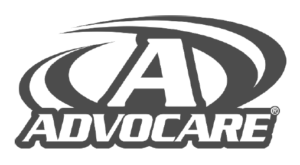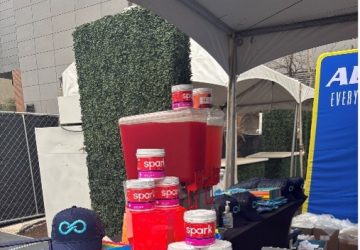This week AdvoCare Sports Advisory Council Members are weighing in with home exercise ideas to help with health and fitness goals while many of us are isolating at home.
In addition, former pro football standout David Thompson’s home workout videos can be found here, and make sure to get in on David’s FREE Facebook Workouts on April 29 (7pmCT), May 6, and May 13! More Info
You might also like: Exercising at Home: 15–, 30– and 45–Minute Circuit Workouts, The 5 Pillars of Fitness, Keeping Your Family Healthy and Active, Home Gym on an Budget, and 10 Fitness Facts You Need To Know.
By Mark Mauldin, Director of Executive Health for Hendrick Motorsports
Here are a few exercise examples that can be done with body weight or objects you can find around your house. Use your own fitness level to decide how many reps and sets to perform for each exercise.
Chest: Stair Push-up Drop Set- This drop set changes the angle of push and utilizes a concept called mechanical advantage. Start with your feet on a stair and do as many push-ups as you can. The higher the stair, the higher the difficulty. Next, put your feet on the ground and do as many reps as you can. If you’re only able to squeeze out a few, you’re doing it right. For the final drop set, put your hands on a stair and rep out as many as possible. The higher the stair, the lower the difficulty.
 Back: Milk Carton (or gallon jug) Standing Rear Delt Raise- Grab two milk cartons or jugs and make sure they are filled to the same level. Soften your knees, bend at the waist, and keep a good flat back. With soft bent arms, squeeze your shoulder blades together and raise the milk cartons out to your sides. Pause slightly, then return to the starting position.
Back: Milk Carton (or gallon jug) Standing Rear Delt Raise- Grab two milk cartons or jugs and make sure they are filled to the same level. Soften your knees, bend at the waist, and keep a good flat back. With soft bent arms, squeeze your shoulder blades together and raise the milk cartons out to your sides. Pause slightly, then return to the starting position.
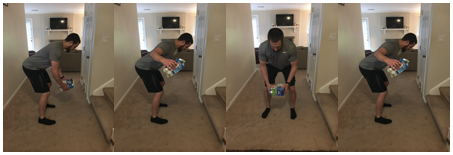 Shoulders: Prone IYTWA Shoulder Series- This series is great for shoulder health. Lie down flat on your stomach. Keep your toes on the ground. In each position pictured, keep your shoulder blades pulled down and squeeze them together. Hold each position for 5-10seconds without dropping between positions.
Shoulders: Prone IYTWA Shoulder Series- This series is great for shoulder health. Lie down flat on your stomach. Keep your toes on the ground. In each position pictured, keep your shoulder blades pulled down and squeeze them together. Hold each position for 5-10seconds without dropping between positions.
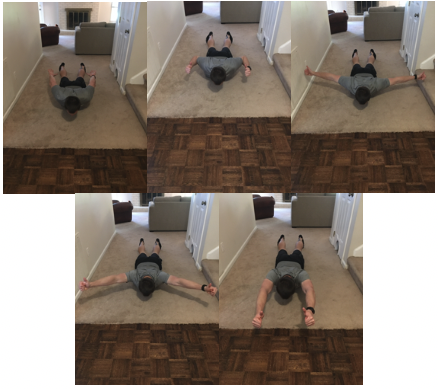
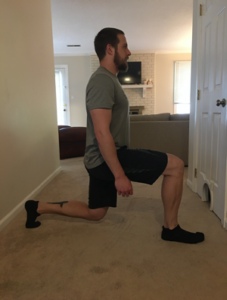 Legs: Split Squat Isometric Hold- Get in a good split squat position. Your front foot should be driven into the ground, your front shin perpendicular to the ground, back knee on the ground, and tall torso with good posture. Raise your back knee off the ground about 2-4 inches. Hold this position. Feel out this movement and hold until you feel a good burn in your quads. Drop, switch legs, and repeat for the same amount of time.
Legs: Split Squat Isometric Hold- Get in a good split squat position. Your front foot should be driven into the ground, your front shin perpendicular to the ground, back knee on the ground, and tall torso with good posture. Raise your back knee off the ground about 2-4 inches. Hold this position. Feel out this movement and hold until you feel a good burn in your quads. Drop, switch legs, and repeat for the same amount of time.
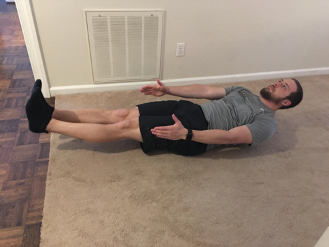 Core: Hollow Body Hold- Lie down flat on your back with legs straight, feet hip width apart and toes pointed up. Lift your feet 6 inches off the ground. Drive your low back into the ground and reach toward the outside of your feet with palms facing. Keep your head neutral. Focus on squeezing your core and driving your low back down. Hold for 20-45 seconds.
Core: Hollow Body Hold- Lie down flat on your back with legs straight, feet hip width apart and toes pointed up. Lift your feet 6 inches off the ground. Drive your low back into the ground and reach toward the outside of your feet with palms facing. Keep your head neutral. Focus on squeezing your core and driving your low back down. Hold for 20-45 seconds.
Weekly Routine Options
Here are two options for a weekly workout routines/combinations. Both options are effective and address all the major muscle groups twice per week. You can try both routines and pick the one that works best for you.
| Lower/Upper/Core Split:
Monday: Lower body Tuesday: Upper body Wednesday: Core Thursday: Lower body Friday: Upper body Saturday: Core Sunday: Recovery day |
Chest & Shoulders/Back/Legs Split:
Monday: Chest & shoulders/triceps Tuesday: Back/biceps Wednesday: Legs/core Thursday: Chest & shoulders/triceps Friday: Back/biceps Saturday: Legs/core Sunday: Recovery day |
By Gene Coleman, Ed. D., RSSC*E, Strength and Conditioning Consultant, Professional Baseball
Single-Leg Forward Reach. This is a good exercise to develop lower body functional strength, balance, and body control. It also develops the sensory feedback loop within the nervous system (proprioception) that helps improve balance and coordination when walking, jogging, running, exercising and playing sports, and helps prevent tripping and falling when moving on uneven and less stable surfaces.
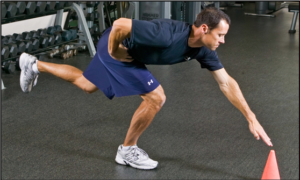 How to do it:
How to do it:
- Stand on your right foot about 2-3 feet in front of a 6 to 12-inch cone.
- Squat on your right leg and slowly bend forward at the waist.
- Allow the left leg to move behind you and keep the right heel on the ground.
- Reach forward and touch the cone with your left hand.
- Return to the starting position and repeat for the desired number of reps.
- Then stand on your left leg and reach forward with your right hand.
Coaching tips:
- Maintain balance throughout the exercise.
- Try to touch the cone on each rep, but stop when your limits of stability have been reached and return to the starting position while maintaining balance on the support foot only.
- Check for excessive bowing out or bowing in at the hip joint and excessive inward or outward movement at the knee and ankle joint.
- You can make it easier by using a taller cone or reaching with both hands or harder by using a shorter cone and reaching farther with one hand.
By Kevin Yoxall, Head Strength and Conditioning Coach, Dallas Renegades
- For home bound training, everyone, no matter their experience/fitness level, needs to do a very honest assessment of their CURRENT physical ability level. This assessment should include not just a physical check list (health, flexibility, strength and cardio fitness) but also time factors involved (best time to train, # of days/week they plan to workout, mental outlook for training).
- If training has not been consistent in the recent past, the starting point should reflect a “less is better” framework.
- A post training assessment each day should be done in order to plan for the next training session. Ideally each session should be a slow/progression forward, adding intensity (no matter the factor) slowly. If starting sessions were too difficult, its ok to dial it back to a more appropriate level.
- Workouts must include and begin with a good warmup, gradual and working into better range of motion. Keep warm-ups simple and to your individual and appropriate/current level of fitness.
- Every workout session should have constant full range of movement, incorporating resistive training and raising the heart rate.
- Setting up short mini sessions throughout the day is another way to break the monotony of a single long session. And it is also a great way to make yourself get up and incorporate movement, interrupting long periods of sitting and poor posture.
By Skylar Richards, Consultant, Athletic Trainer and Sports Scientist
Home Rolled Exercises. Don’t let your at-home workout get stale. Instead, focus on improvising with household items that roll.
Find or select a “rolling” device ◦ Rolling chairs, stools, foam roller, skateboard, large kick balls, etc. ◦ Position yourself in the room so that there is something to limit your motion such as a wall to run into. A well-positioned towel on the ground works nicely as well.
Hamstrings ◦ Lie on your back and put your heels on the device with knees bent ◦ Extend your heels away from your body and pull them back under control.
Abs ◦ Begin kneeling on all fours with your arms, hands or elbows on your rolling device ◦ Slowly extend your hips and arms to make yourself as long as possible and then return while maintaining control.
Adductors ◦ Standing, put your hands on hips and one foot on your rolling device (It is preferable to use a device that’s as low as possible) ◦ Perform a single leg squat with your stable leg, while your “rolling” leg moves laterally away from your body as far as you can while maintaining control ◦ This can be also be done with a front or rear movement to challenge different muscle groups.
While these movements are some of our favorites, don’t limit yourself to these. Get creative and then spread your inspired exercises around to motive others in the same dilemma!
By Jennifer Jones, Assistant Athletic Director for Sports Performance at Auburn
Home workout #1
Workout may be adjusted for beginner to advanced fitness levels simply by adding more rounds
- Warm-up with 10-20 min walk/jog
- Push-ups (regular or on your knees) x 20 seconds
- Rest 10 seconds and repeat (beginners – 3 rounds, advanced – 8 rounds)
- Once you have completed all rounds of push-ups rest 1 minute
- Body weight squats X 20 seconds
- Rest 10 seconds and repeat (beginners – 3 rounds, advanced – 8 rounds)
- Once you have completed all rounds of body weight squats rest 1 minute
- Burpees x 20 seconds
- Rest 10 seconds and repeat (beginners – 3 rounds, advanced – 8 rounds)
- Once you have completed all rounds of burpees rest 1 minute
- Mountain climbers x 20 seconds
- Rest 10 seconds and repeat (beginners – 3 rounds, advanced – 8 rounds)
In this circuit you will complete 4 total exercises, working for 20 seconds with 10 seconds rest. Total time if you complete 3 rounds of each exercise is 10 minutes of work (not including warm-up)
Home Workout #2 – Core/Total Body Circuit
- Squat to overhead press (use any heavy object ex. Laundry detergent jug)
- High plank to shoulder taps (pushup position and alternate tapping opposite shoulder)
- Body saw https://youtu.be/7mRhqSp1MIA
- Side plank either straight arm or on bent arm (left side)
- 1 arm over head lunge (use any heavy object overhead with 1 arm while performing lunge)
- Side plank either straight arm or on bent arm (right side)
Home Workout #3
Use the letters in your first & last name to create a workout. Other fun and creative ideas, use the month and day of the week, or use your favorite AdvoCare Spark flavors.
| A | 50 | Jumping jacks | N | 25 | Burpees |
| B | 20 | Crunches | O | 40 | Jumping jacks |
| C | 30 | Squats | P | 15 | Plyo lunges |
| D | 15 | Push-ups | Q | 30 | Crunches |
| E | 1 | Minute wall sit | R | 15 | Push-ups |
| F | 10 | Burpees | S | 30 | Jump squats |
| G | 20 | Plyo lunges | T | 15 | Burpees |
| H | 20 | Jump Squats | U | 30 | Bench dips |
| I | 30 | Jumping jacks | V | 1 | Minute wall sits |
| J | 1 | Minute plank | W | 50 | Calf raises |
| K | 10 | Push-ups | X | 60 | Jumping jacks |
| L | 20 | Bench dips | Y | 2 | Minute plank |
| M | 20 | Burpees | Z | 20 | Push-ups |
AdvoCare Sports Advisory Council Members are compensated for their AdvoCare Sports Advisory Council Member roles. This information is for educational use only and represents the honest opinions of the author. Before beginning any exercise program or changing your physical activity patterns, you should always consult with your doctor or physician, particularly if you have been injured or have a medical condition.
